Pest & Crop Newsletter, Entomology Extension, Purdue University
- Expect the Unexpected When Top Soil is Dry
- Corn Rootworm Hatch is Underway in West Central Indiana
- Black Light Trap Catch Report
- Accumulated Heat Units Base 50
![]()
Expect the Unexpected When Top Soil is Dry – (Christian Krupke, John Obermeyer, and Larry Bledsoe)
- Normally trivial insects can become pests on stressed crops
- Prior crops/weeds allow for insect establishment
- Seed-applied insecticides may be of little use in exceptionally dry conditions.
Uneven crop emergence is pervasive throughout the state, particularly in the north. Generally, hot and dry weather at this point in the growing season lowers the threat of our typical spring insect problems (grubs, wireworms, cutworms), which are typically exacerbated by cool, moist soils. However, when the soil environment becomes extremely hot and dry during seedling development and emergence, normally obscure critters can become stand-destroying pests.
Insects, and other arthropods, are opportunists. When a preferred food host that provides needed nourishment is removed, they improvise. Often, what we think of as “bizarre” crop damage situations are directly tied to unique cropping/tillage history of an area or whole field. In other words, these critters built up populations unnoticed on weeds or other crops, and are not noticed until “forced” to change diets.
No-till fields: Millipedes are wireworm-like that move slowly above and below the ground. They typically feed as scavengers, feeding on dead or decaying materials often associated with high residues. They have rarely been documented as pests of corn as they nibble at the corn’s seminal roots and mesocotyl for moisture in very dry soils. There is no known treatment for these multi-legged arthropods.

Millipede and damaged corn roots
Former pasture or set-aside: A complex of weevils, e.g., alfalfa weevil, have been known to damage soybean stands where pastures once existed. Even though tilled, these beetles may still be present in large enough numbers to flock to “juicy” soybean hypocotyls, feeding enough to cause wilting and plant death. This has also been seen in soybean rows adjoining forages that have been cut during dry weather, as the beetles migrate toward a food source.

Weevil complex damage to soybean seedlings
Weedy before/during planting: Several species of non-crop insects have been known to damage emerging seedlings because their weedy host was taken away by tillage or herbicides. False chinch bugs, burrower bugs, and even sphinx moth caterpillars have been seen in years past attempting to feed on crops after their weed-host has been destroyed. Though they can be quite numerous, they normally starve to death before killing the crop because of their specific nutrient needs.

Borrower bug nymphs (Photo credit: Kevin Black)
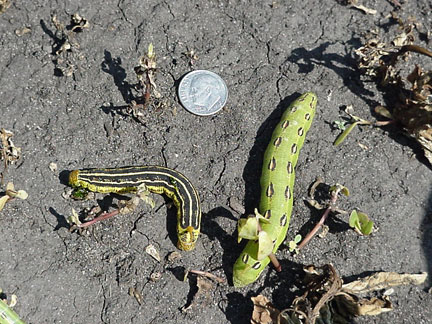
Sphinx moth caterpillars (hornworms) looking for food
When the topsoil is bone dry, normally sub-lethal numbers of insect pests, e.g., grubs and wireworms, can further weaken and kill a stressed corn/soybean seedling. Unfortunately when seedlings are stressed, the seed-applied insecticides, i.e., Cruiser and Poncho, are poorly translocated through the plant and provide little to no protection. Sleuthing erratic stands now goes a long way toward gaining field history and averting potential pest pressures of the future. Happy scouting and take your camera!
![]()
Corn Rootworm Hatch is Underway in West Central Indiana - (Christian Krupke, John Obermeyer, and Larry Bledsoe)
- Hatch of rootworm in WC Indiana occurred on or around
May 18. - Sampling for larvae and assessing insecticide performance will be possible in a couple weeks.
- Early egg hatch probably means earlier adult emergence this summer.
The warm temperatures have resulted in the appearance of rootworm in corn roots about a week and a half earlier than what was observed last year, see yearly comparison below. A rootworm larva was collected from V3 corn on May 23 near Lafayette in Tippecanoe County. Because the larva was a second instar, it is likely that it hatched at least 5 days earlier. Hatch in southern Indiana counties typically occurs several days earlier while hatch in northern counties is underway. This is just a benchmark date and of little significance for the producer – the hatch is very prolonged and eggs will continue to hatch for several more weeks with the peak hatch at early to mid June. Anyone still planting or replanting corn during the next two weeks should consider using a soil insecticide to protect the roots of emerging plants.
It is too soon to sample for rootworms, as the larvae are very small and inside the roots. However, they grow quickly and in mid to late June, sampling will give an indication of the performance of a soil/seed insecticide, if one was applied at planting, or those waiting to determine the need for a soil insecticide at cultivation. This requires digging up and breaking the soil away from the roots of several plants in a field. Roots and surrounding soil must be carefully examined for rootworm larvae. Small (1/8 to 1/2 inch in length), slender, white larvae with brown head and tail sections. More on this sampling will be in a future issue of the Pest&Crop.
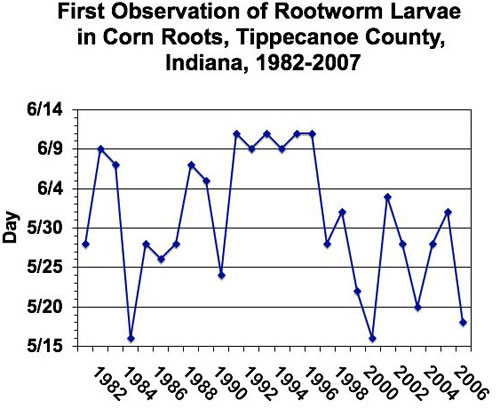
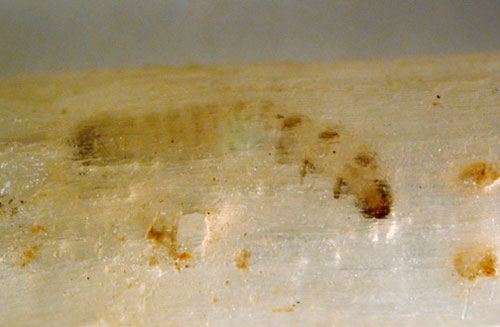
Rootworm hatchling inside corn root
![]()
Bug Scout says, "Black cutworm leaf feeding is possible throughout Indiana. Cutting is most
likely from this point south. Happy Scouting!"
Click here to view the
Black Light Trap Catch Report - (John Obermeyer)
Variable Emergence Due to Variable Seedbed Moisture - (Bob Nielsen)
One of several requirements for uniformly quick germination in corn (Nielsen, 2007a) is uniformly adequate soil moisture in the seed zone. When seedbed soil moisture is variable (too dry vs. just right or too wet vs. just right), germination and emergence will also be variable.
Corn planted during the past couple of weeks in parts of Indiana has occurred in soils that have dried quickly in response to a string of warm, sunny days with strong winds and low humidity levels. Tilled seedbeds in particular have dried very quickly at the surface and sometimes unevenly.
Coupled with shallow compacted tillage layers that sometimes prevent planter row units from placing seed as deeply as the depth setting targets, kernels within inches of each other in the seed furrow can experience significantly different soil moisture levels. In other situations, growers may have neglected to change planter depth settings in response to the depth at which soil moisture was more uniform.
Last Friday I came across an example of fairly dramatic uneven emergence caused by variable soil moisture in a conventionally tilled field (corn following soybean) that was planted May 7. I estimated 75 to 80% of the field was comprised of “normal” emergers that were at the late V1 leaf stage (one leaf with a visible collar). Some late emergers were barely breaking through the surface, while others were yet in the process of elongating towards the soil surface.
Still other kernels showed no visible signs of germination (Nielsen, 2007b), suggesting they had not imbibed enough moisture to initiate the germination process. The non-germinated kernels were otherwise healthy with no evidence of disease or insect injury.
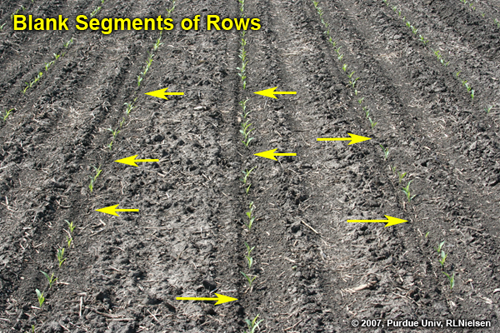
Field with numerous short blank segments of row.
Given that the initial emergers were at late V1, if the non-germinated kernels eventually germinate and emerge they will likely be out-competed and not contribute to yield. Even the late emergers that were barely visible on May 18 will likely experience enough competition with their neighbors that are almost two leaves farther advanced that they will not contribute 100% to grain yield.
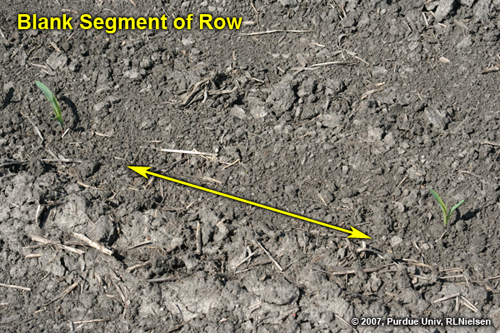
Closer view of short (3 missing plants) blank segment of row.
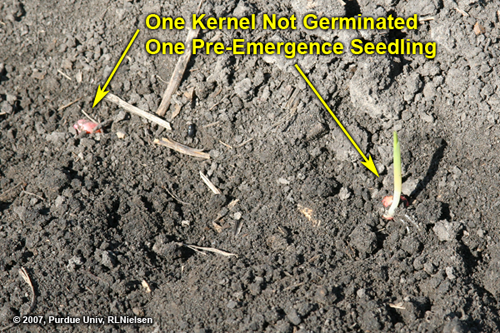
Non-germinated kernel (left) and delayed emerger (right)
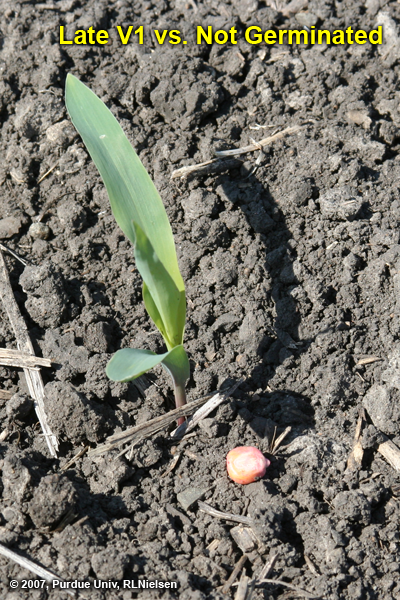
"Normal" emerger at late V1 leaf stage and non-germinated kernel uncovered in seed furrow about 6 inches down the row from the "normal" emerger.
Seed spacing among the normal emergers suggested an initial seeding rate of 33000 seeds per acre. I estimated the percent of delayed emergers or non-germinated kernels to be no less than 20% of the stand. Yield loss due to such delayed emergence is roughly similar to that due to low population. Based on the initial seeding rate and the plant population yield response tabular data published in Purdue’s ID-179, Corn & Soybean Field Guide, the estimated yield loss in this field would thankfully only be 1 to 2 percent (33000 vs 26). If the initial seeding rate had been closer to the lower end of the optimum range, say closer to 28000 seeds per acre, the predicted yield loss due to 20% fewer contributing plants would have somewhat higher at about 5 percent.
Related References
Carter, Paul, Emerson Nafziger, and Joe Lauer. Uneven Emergence in Corn. North Central Regional Extension Pub. No. 344. [On-Line]. Available at <http://learningstore.uwex.edu/pdf%5CNCR344.pdf>. (URL verified 4/23/07).
Nielsen, R.L. (Bob). 2007a. Requirements for Uniform Germination and Emergence of Corn. Corny News Network, Purdue Univ. [On-Line]. Available at <http://www.kingcorn.org/news/timeless/GermEmergReq.html>. (URL verified 5/20/07).
Nielsen, R.L. (Bob). 2007b. Visible Indicators of Germination in Corn. Corny News Network, Purdue Univ. [On-Line]. Available at <http://www.kingcorn.org/news/timeless/GerminationGallery.html>. (URL verified 5/20/07).
![]()
Be on the Alert for Floppy, Rootless Corn - (Bob Nielsen)
After a delayed start due to excessively wet field conditions, corn planting progress in Indiana accelerated during the past three weeks as the rains subsided (Fig. 1). That’s the good news. The bad news is that the rains have subsided (Fig. 2). That fact plus mid-summer temperatures, low humidity levels, and frequently windy days have combined to quickly dry out surface soil in many fields (Fig. 3) and the young corn crop is feeling the effects.

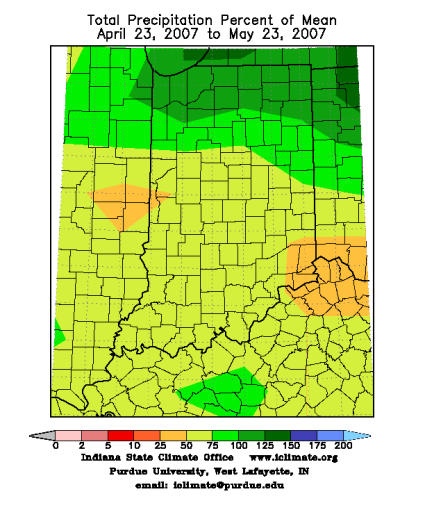
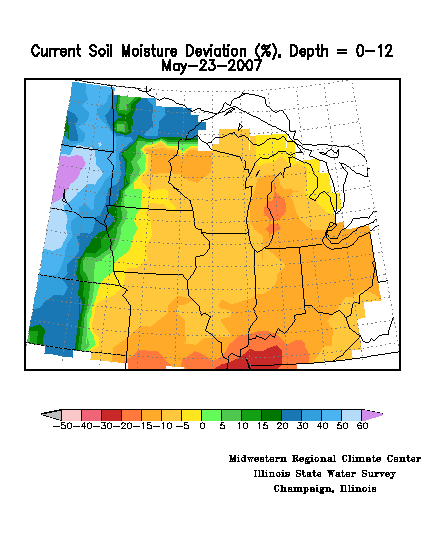

The excessive drying of the upper soil profile is conducive for the development of what some of us affectionately call the “rootless corn” or “floppy corn” syndrome. The problem illustrates a classic example of the importance of the timing of stress and plant development.
The permanent (nodal) roots of a corn plant develop initially from near the crown area of the plant (Nielsen, 2007a). They develop sequentially in sets or “whorls” from individual nodes of the stalk. The growing point or meristem of a root lies near the root tip and must remain alive in order for the root to develop normally.
Contrary to popular opinion down at the coffee shop, roots do not grow toward moisture on purpose. They grow downward in response to gravity (i.e., a gravitropic response). If nodal roots begin development in bone-dry surface soil but elongate into soil moisture at deeper depths prior to desiccation of the root tip, then the root will survive and proliferate.
If the root tip (and accompanying meristem) desiccates prior to reaching soil moisture, the entire young nodal root will likely die. This is particularly true if the axillary meristems along the length of the root (that eventually produce the branch roots) have not yet differentiated or become active.
The appearance of such a desiccated root is what one would imagine; shriveled and discolored. This symptom is unlike that of any other lethal root stress, including salt injury from fertilizer. These symptoms are NOT like any associated with herbicide injury or insect feeding. Because several sets of roots may not have formed belowground, the crown may “appear” to be at or above the surface. That appearance is an optical illusion except in a few cases (Nielsen, 2004).

Entire sets or “whorls” of nodal roots sometimes die in this manner and the plant essentially survives on what’s left in the kernel reserves and what the seminal roots offer in terms of moisture and nutrient uptake until the next set of nodal roots develop and become established. If subsequent sets of nodal roots die in the same manner, the plant continues its dependence on the kernel and seminal root support.
In fact, it is amazing to me how the aboveground appearance of a plant affected with the “rootless” syndrome can remain fairly normal up until the windy day when the mesocotyl simply can no longer support the plant and it flops over to the ground. “Floppy” corn plants are NOT technically root-lodged; they are simply broken over at the mesocotyl below the crown area of the plant. Obviously, the health of the mesocotyl and the seminal roots determine whether an affected plant can “hang on” until a decent soaker occurs to replenish soil moisture levels.

Example of "floppy corn" syndrome
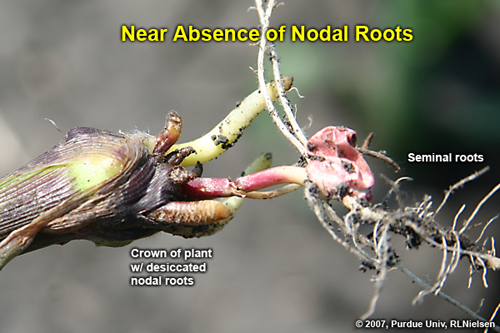
Desiccated, dead nodal roots
What Can Be Done? Unfortunately, very little can be done to prevent the situation from becoming worse. Row cultivation may encourage new nodal root development if moist soil is thrown around the base of the plants. However, if the soil is dry enough to be causing the problem in the first place, there’s probably very little moist soil shallow enough to be brought up by row cultivation. The ultimate solution to the problem is a good soaking rain or at least enough of a rain to sustain new nodal root development long enough to allow the roots to reach deeper and hopefully wetter soil conditions before the upper soil dries again.
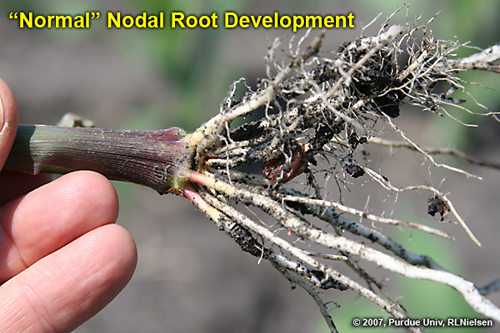
Nodal roots of "normal" plant
A “Hindsight” Reminder. “Rootless” corn can also be aggravated by extremely shallow seeding depths that result in nodal root initiation beginning near the soil surface rather than at the usual 3⁄4 inch depth. This is one of several reasons that growers should avoid choosing seeding depths shallower than about 1 to 11⁄2 inches.
Related References
Elmore, Roger and Lori Abendroth. 2007. Rootless Corn Syndrome. Integrated Crop Management Newsletter, Iowa State Univ. [On-Line]. Available at <http://www.ipm.iastate.edu/ipm/icm/2007/5-21/rootless.html>. (URL verified 5/23/07).
Nielsen, R.L. (Bob). 2004. Over-Extended Mesocotyls and Floppy Corn Syndrome. Corny News Articles, Purdue Univ. [On-Line]. Available at <http://www.kingcorn.org/news/articles.04/FloppyCorn-0624.html>. (URL verified 5/23/07).
Nielsen, R.L. (Bob). 2007a. Root Development in Young Corn. Corny News Articles, Purdue Univ. [On-Line]. Available at <http://www.kingcorn.org/news/timeless/Roots.html>. (URL verified 5/23/07).
Nielsen, R.L. (Bob). 2007b. Variable Emergence Due to Variable Seedbed Moisture. Corny News Articles, Purdue Univ. [On-Line]. Available at <http://www.kingcorn.org/news/articles.07/VariableEmergence-0520.html>. (URL verified 5/23/07).
![]()
Prevalent Purple Plants Puzzle Producers - (Bob Nielsen)
As folks trickle back into the Chat ‘n Chew Café after several weeks of intensive planting efforts, conversations are beginning to drift toward the condition of the young crop. A number of the café’s regulars are reporting that whole fields have taken on noticeable shades of red and purple over the past week or so. Landlords and tenants alike are wondering what on earth is wrong with these fields.

Moderately purple corn
Purpling of corn plant tissue results from the formation of a reddish-purple anthocyanin pigments that occur in the form of water-soluble cyanidin glucosides or pelargonidin glucosides (Hak, 1998). A hybrid’s genetic makeup greatly determines whether corn plants are able to produce anthocyanin. A hybrid may have none, one, or many genes that can trigger production of anthocyanin. Purpling can also appear in the silks, anthers and even coleoptile tips of a corn plant.
Well, you may say, that’s fine but what triggers the production of the anthocyanin in young corn at this time of year? The answer is not clearly understood, but most agree that these pigments develop in young plants in direct response to a number of stresses that limit the plants’ ability to fully utilize the photosynthates produced during the day. These stresses include cool night temperatures, root restrictions, and water stress (both waterlogged and droughty conditions).
There’s no question that many cornfields throughout the state have suffered through dry soil conditions during the past several weeks. Furthermore, soil compaction (tillage- or planter-related) is more prevalent this year that restricts the development of the initial root systems. The additional stresses imposed by recent relatively cool nights (low 50’s F, last Friday’s mid-30’s) and bright sunny days (high levels of visible and UV radiation) may be the final “triggers” that result in fields of pretty purple plants.
Since the anthocyanin occurs in the form of a sugar-containing glucoside, the availability of high concentrations of sugar in the leaves (photosynthesis during bright, sunny days) further encourages the pigment formation. If fields are stressed by other factors such as soil compaction, herbicide injury, disease damage, or insect injury, the purpling becomes even more pronounced.
It has been my experience that the combination of bright, sunny days and cool nights when corn ranges from V3 to V6 in development (3- to 6-leaf collar stages) most commonly results in plant purpling. Hybrids with more anthocyanin-producing genes will purple more greatly than those with fewer “purpling” genes. In most cases, the purpling will slowly disappear as temperatures warm and the plants transition into the rapid growth phase (post-V6).
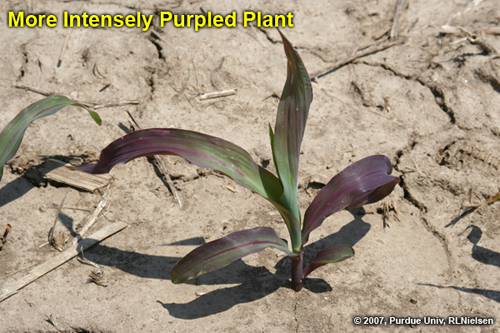
More intensely purple plant
I have rarely diagnosed phosphorus deficiency as the primary cause of purple plants early in the season. Nonetheless, cold or wet soils inhibit root development and can aggravate a true phosphorus deficiency situation, frequently causing even more intense leaf purpling.
What About Yield Losses? Does the leaf purpling lead to yield losses later on? The cause of leaf purpling, not the purpling itself, will determine whether yield loss will occur by harvest time.
If the main cause is the combination of bright, sunny days and cool nights, then the purpling will disappear as the plants develop further with no effects on yield. If the stress of restricted root systems is a major contributor to the purpling, then the potential effects on yield depend on whether the root restriction is temporary (e.g., cool temperatures & wet soils) or more protracted (e.g., soil compaction, herbicide injury). Plants can recover from temporary root restrictions with little to no effect on yield. If the root stress lingers longer, the purpling may continue for some time and some yield loss may result if the plants become stunted.
Related References
Chalker-Scott, Linda. 1999. Environmental Significance of Anthocyanins in Plant Stress Responses. Photochemistry and Photobiology 70(1): 1–9.
Christie, P.J., Alfenito, M.R., and Walbot, V. (1994). lmpact of low- temperature stress on general phenylpropanoid and anthocyanin pathways: Enhancement of transcript abundance and anthocyanin pigmentation in maize seedlings. Planta 194: 541-549.
Dixon, Richard A. and Nancy L. Paiva. 1995. Stress-lnduced Phenylpropanoid Metabolism. The Plant Cell 7:1085-1097. American Society of Plant Physiologists. [On-Line]. Available at <http://www.plantcell.org/cgi/reprint/7/7/1085>. (URL verified 5/23/07).
Kim, Jae Hak. 1998. Maize Anthocyanin Pathway. Pennsylvania State Univ. [On-Line]. Available at <http://scripts.cac.psu.edu/courses/plphy/plphy597_hef1/mpath.html>. (URL verified 5/23/07). Editorial note: This link is for biochemistry fans!
For other Corny News Network articles, browse through the CNN Archives at <http://www.kingcorn.org/news/archive.html>. For other information about corn, take a look at the Corn Growers’ Guidebook at <http://www.kingcorn.org>.
![]()
Dehydrated Soybean Seeds: Are They Still Viable? – (Shawn Conley)
Variable and delayed emergence in conventional (more common) and no-till soybean is raising replant and seed viability questions in several pockets across the Midwest. If soybean was planted into dry soil and had not imbibed water (seed did not swell) then there is little to no concern for growers. Once a significant rainfall event occurs the soybean will imbibe water, germinate, and emerge as normal. For yield estimates we would assign the day it rained as the new planting date.
The more difficult question to answer is how viable is the soybean seed once imbibition and/or germination has begun. The critical seed moisture content for soybean is 20% moisture. A soybean seed that has imbibed water, has a split seed coat, or has an emerged radicle will continue to germinate and grow as normal once the seed is re-hydrated if the seed (germ) remains above 20% moisture (Senaratna and McKersie, 1983).
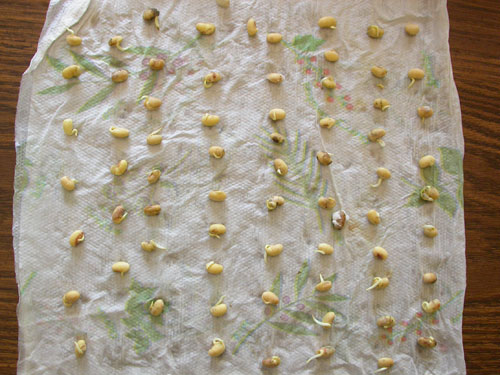
Stages of soybean germination
If the moisture content within a soybean seed falls to10% then a dramatic difference exists among the different seed germination stages. If the seed has imbibed water for 6 hours (I am assuming this means the seed has swelled but the seed coat has not broken) then the seed is dehydrated to 10% moisture, germination is not affected. If the seed has imbibed water for 12 to 24 hours (seed coat broken, but prior to radicle emergence then germination is reduced to 60 to 65%. If the radicle has emerged and seed moisture levels drop to 10% then no survivors can be expected.
To test seed viability growers can conduct a simple germination test. First excavate 100 soybean seeds and wrap them in a damp paper towel. Place these seeds in a warm location and after 24 to 36 hours count the number of seeds that have germinated. Remember that a typical soybean percent germination is 90%.
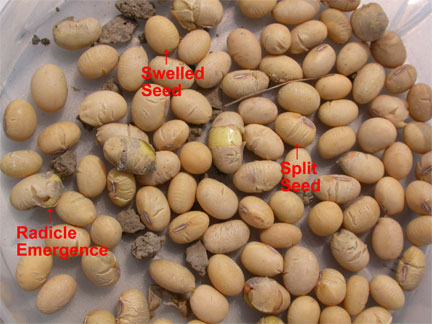
Results of soybean germination test
Literature Cited:
Senaratna, T. and B.D. McKersie. 1983. Dehydration Injury in Germinating Soybean (Glycine max L. Merr.) Seeds. Plant Physiology 72: 620-624.
Acknowledgements:
I would like to thank Jeff Nagel, Agronomist for Ceres Solutions, LLP for the attached images.
Program Will Help Growers Learn How to Better Manage Pastures - (Julie Douglas, Ag Answers Editor/Writer and Keith Johnson)
A Purdue University Pasture Walk will cover management plans from creation to implementation to help improve production efficiency at the Waukaru Farm in Rensselaer, Ind.
Barry and Toby Jordan, growers of registered short horn cattle, will host the Pasture Walk June 12 from 11 a.m. to 1 p.m. (EST). The hands-on program is free and open to the public.
The Waukaru Farm recently made improvements to their pasture management plan by implementing a perennial pasture system. They also utilize corn residues to help fulfill grazing needs.
Participants will interact with forage experts and have the opportunity to ask questions specific to their operation, said Bryan Overstreet, Purdue Extension educator and program coordinator. Speakers include Keith Johnson, Purdue Extension forage specialist and Susannah Hinds with the United States Department of Agriculture's Natural Resources and Conservation Services in Indiana. Hinds will give information about available funds to help growers make improvements on their farm. Johnson will evaluate the well being of the pasture and take inventory of existing resources including forages.
We will look at the existing fence, water supply, weed issues, soil type and fertility, as well as take into account the goals of the farm, Johnson said. We will also discuss means to further enhance the goals of the operation. Growers can take advantage of corn fields after harvest for grazing purposes, Johnson explained.
The quality of corn residue is not high, but neither are the nutritional needs of cows that have just weaned calves, he said. The Pasture Walk is sponsored by Purdue Extension, Jasper County Soil and Water Conservation District and the Newton County Soil and Water Conservation District.
The Waukaru Farm is located at 7577 S. 210 E., Rensselaer, Ind. For questions and more information contact Overstreet at (219) 866-5741.



